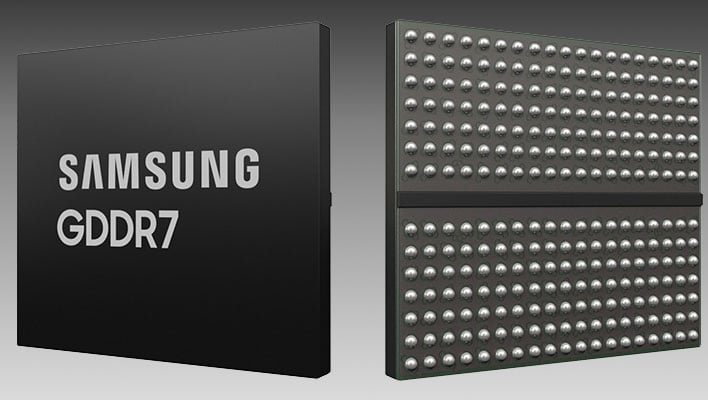Samsung Flexes GDDR7 DRAM At A Blistering 1.5TB/s To Fuel Next-Gen Graphics

Samsung is claiming a key victory against rival Micron in the race to bring next-generation graphics memory to market. While not exactly stated in so many words, what Samsung did say is that it has wrapped up development of what it is touting as the industry's first GDDR7 DRAM, with a huge performance uplift compared to current-generation GDDR6 solutions.
It's also more power efficient to the tune of 20%, according to Samsung, which further states that manufacturers will have access to a low operating voltage option for lower power laptops and other devices that need to be "especially mindful of power usage."
GDDR7 employs Pulse Amplitude Modulation (PAM3) signaling rather than PAM4 like in GDDR6X and Non Return to Zero (NRZ) used in GDDR6. The JEDEC standards body settled on PAM3 for GDDR7 because it isn't as susceptible to noise as PAM4, and it supports higher data transmission speeds than NRZ (50% more). You can think of PAM3 as a sort of middle ground between the two.
The kind of speed that's on tap here is 1.5 terabytes per second (TB/s). That's a 1.4X uplift over GDDR6X (1.1TB/s), with transfer rates boosted to 32 gigabits per second (Gb/s) per pin. To put that into perspective, the fastest GDDR6X memory employed today on graphics cards can be found on NVIDIA's GeForce RTX 4080, which uses 22.5Gbps memory chips.
What about the GeForce RTX 4090, NVIDIA's flagship consumer GPU? It actually uses 21Gbps GDDR6X memory, but it also has a fatter 384-bit memory bus to achieve over 1TB/s of memory bandwidth (versus 256-bit and 716.8GB/s on the RTX 4080).

"Our GDDR7 DRAM will help elevate user experiences in areas that require outstanding graphics performance, such as workstations, PCs and game consoles, and is expected to expand into future applications such as AI, high-performance computing (HPC) and automotive vehicles," said Yongcheol Bae, Executive Vice President of Memory Product Planning Team at Samsung Electronics. "The next-generation graphics DRAM will be brought to market in line with industry demand and we plan on continuing our leadership in the space."
Bandwidth and power efficiency aside, Samsung is also touting the use of an epoxy molding compound with a high thermal conductivity profile in the packaging material for GDDR7. Combined with optimizations to the IC architecture, Samsung claims it was able to "dramatically reduce thermal resistance by 70% in comparison to GDDR6." The upshot is better stability in high-speed operations, Samsung says.
Samsung's roadmap calls for key customers to test its GDDR7 memory in next-generation systems later this year. The likely timeline for actual products that use GDDR7 is next year, and probably towards the end for next-gen GPUs like the GeForce RTX 50 series and whatever AMD has on tap with RDNA 4.

